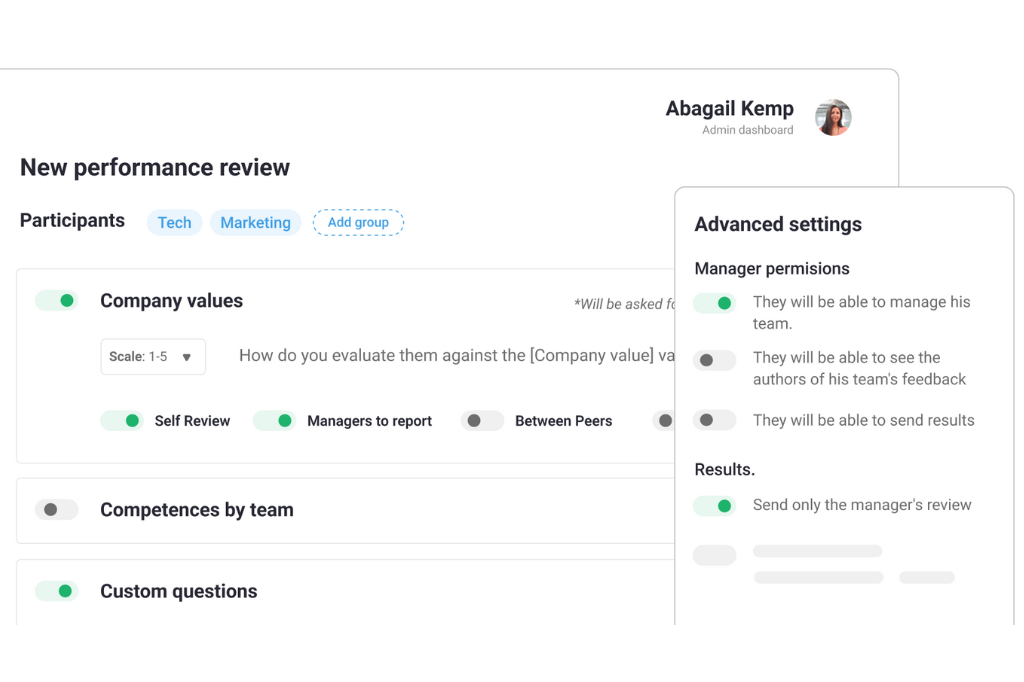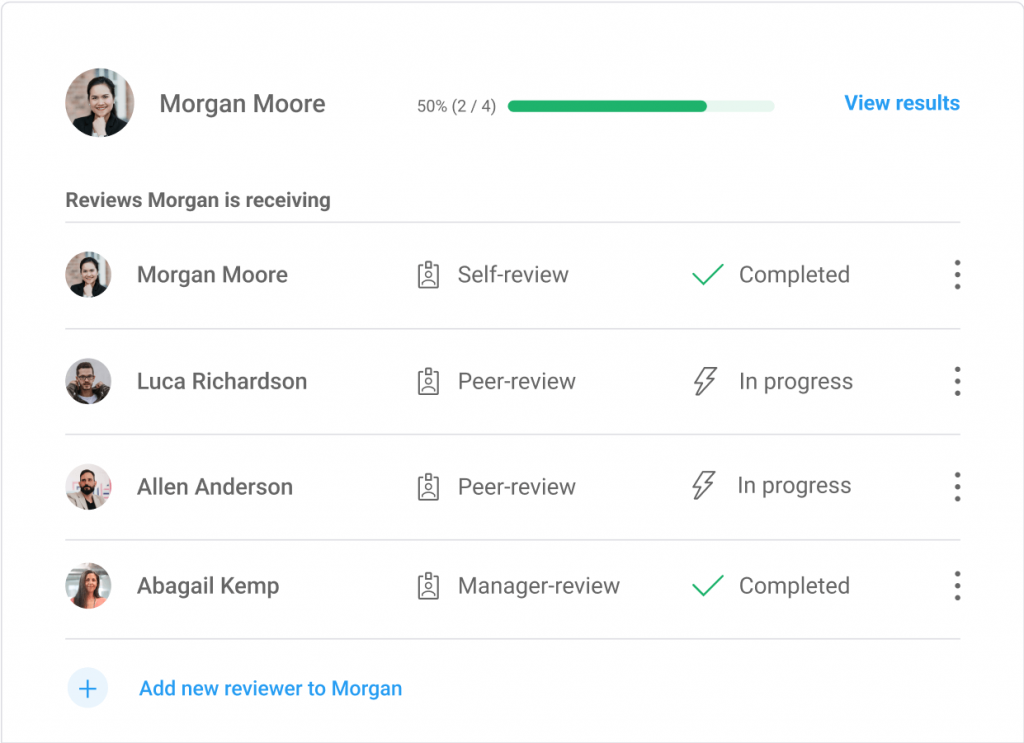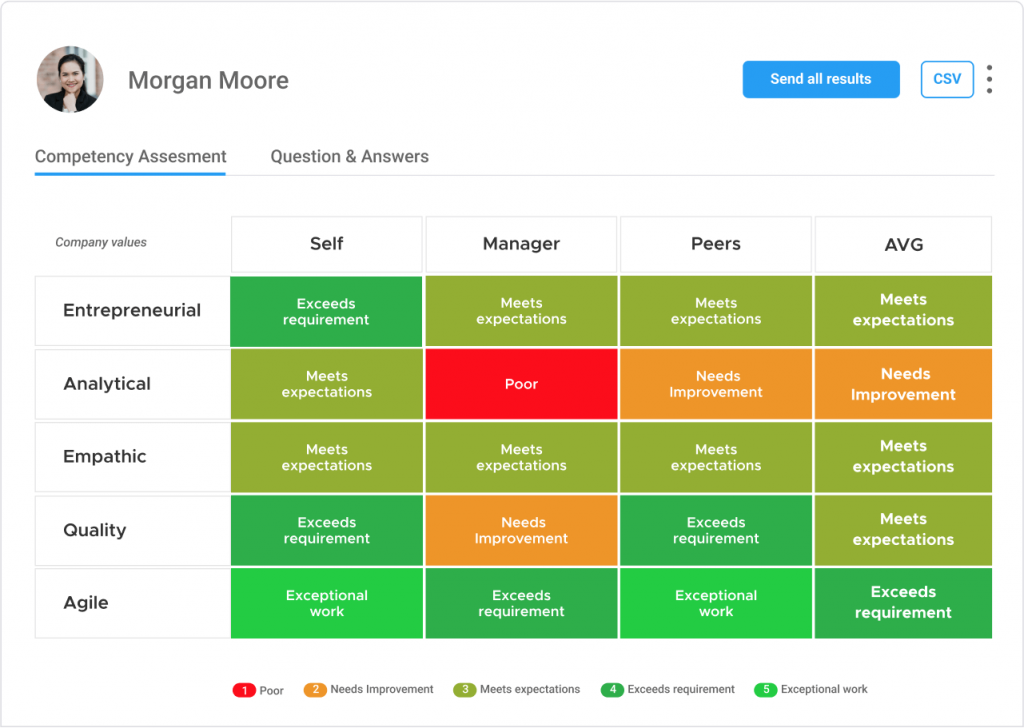Performance reviews are the cornerstone of growth, development, and success for both employees and organizations. In previous articles we’ve already highlighted the relevance of conducting effective performance reviews and we’ve given you examples and templates to use. However, we haven’t told you how to conduct a performance review!
A well-structured performance review can be a powerful tool for recognizing and improving employee performance. But it also helps align individual goals with organizational objectives, and foster a culture of open communication and continuous improvement. Do you want to know how to conduct a performance review correctly?
The following words will guide you through the intricate process of designing, launching, and managing a performance review to achieve meaningful results. We’ll explore the key steps, best practices, and strategies to create a performance review process that not only evaluates past events but also lays the foundation for future success.
Preparing for a performance review
To ensure that performance reviews are both effective and constructive, it is crucial to approach this process with careful planning and thoughtful consideration. There are various aspects that organizations should take into account when preparing for a performance review. From setting clear goals and communicating the process to employees, to defining the right questions and measurement scales. If you still want to discover how to conduct a performance review, the process starts right here!
- Analyzing your company
- Setting clear objectives
- Evaluating how this process fits with others
- Defining the purpose of the performance review
- Defining the right time and periodicity
- Including the right questions
- Choosing the right measurement scale
- Choosing a performance review platform
- Communicating the purpose and process to employees
Analyzing your company
Before conducting a performance review, it’s highly important to turn your attention inward and thoroughly analyze your company. This self-reflection can significantly impact the quality and effectiveness of your performance review process.
Understanding your company culture, values, and goals will enable you to tailor performance reviews to align with your organization’s specific situation, needs and objectives. Take the following into consideration:
- Align with company culture and values: recognize and embrace your distinct culture and values in your performance reviews. When employees see that the evaluation process is aligned with the culture and values, they are more likely to feel engaged and motivated. It also reinforces the importance of these values in the daily work of your employees, contributing to a more cohesive and purpose-driven workforce.
- Reflect on your company goals: performance evaluations should serve as a tool to help employees contribute to these goals. By understanding your company’s short-term and long-term goals, you can set performance expectations, fostering alignment and a sense of purpose among employees.
- Adapt to the organizational structure: the hierarchy of your organization plays a significant role in how performance reviews should be conducted. Different organizations have different layers of management and reporting structures. Being mindful of these distinctions ensures that your performance review process is a practical and integrated part of your company’s workflow.
- Be clear about the maturity of the different teams and managers: this will help you decide if, for example, it is better to create an anonymous review or what would be the best scale to use.
Setting clear objectives
Setting clear company goals forms the foundation upon which the entire process rests and is essential for its success. Without having previously defined goals, the practicality of the evaluations will be reduced.
- Clarity and alignment: having clear objectives provide both managers and employees with a roadmap for the performance review process. Without well-defined goals, the review can become a vague and subjective review, making it difficult to assess progress and make meaningful improvements.
- Expectation management: when employees know what is expected of them during a performance review, they can prepare adequately and participate more constructively. Moreover, managing expectations accordingly reduces anxiety and uncertainty.
- Performance improvement: having objectives enables managers and employees to identify specific areas of improvement. Therefore, the performance review process becomes a catalyst for positive change and progress.
- Measurable outcomes: when you have goals to achieve, you have a number to reach. Measurable outcomes are essential for fair and consistent evaluations, making the performance review process more data-driven and less subjective.
- Better feedback: clear objectives establish accountability for all parties involved. Employees have a clear understanding of what they are striving to achieve, and managers have a framework for providing constructive feedback.
Evaluating how this process fits with others
Consider how the process fits within the larger context of your company’s various operational and talent management processes. The synergy between performance reviews and these processes are key to creating the perfect performance review.
- Other people management process: performance reviews are intricately linked to your other people’s strategies. Consider how the feedback and data gathered during performance reviews can contribute to talent acquisition, training and development, and compensation decisions, among others. This will help you create a more efficient approach to engaging your workforce.
- Administrative tasks: consider how the performance review process aligns with other administrative tasks and technologies used in your company. Streamlining these processes can reduce the administrative burden, making performance reviews less disruptive to daily operations. This alignment can include the integration of a performance review software.
- Other kinds of reviews: it is important to consider whether this new review will occur at the same time as other reviews. For example, you may have launched a company-wide values and culture review at the same time as a competency and skills review for the marketing team.
Defining the purpose of the performance review
Keep in mind that you will need to design your performance review based on what you want to achieve with it. The purpose sets the tone, expectations and outcomes of the review process. It also determines the questions employees will be asked to answer. Here you have a list of a few examples of performance reviews’ purposes:
- Evolution and goals at 6 months: this review focuses on tracking the employee’s evolution over the prior six months and how their goals are expected to develop in the upcoming half-year. It serves as a valuable approach for establishing forthcoming objectives.
- Competencies and skills: it evaluates the precise skills and competencies essential for each job role. This particular approach aids in pinpointing the areas where an employee might require improvement.
- Job satisfaction: this review gauges employee satisfaction and their level of comfort in their current role. It proves highly effective when HR is seeking to pinpoint issues related to retention.
- Customer relationships: this review assesses the quality of service employees provide to clients. It’s important to note that this review isn’t tailored solely for customer success teams; rather, it’s applicable to all staff members who interact with customers.
- Value alignment: creating a company in which there is harmony between the employees and the corporate values is pivotal for achieving workplace success.
- Interpersonal relationships and teamwork: this review focuses on evaluating the extent of cooperation and mutual synergy among team members. It studies skills related to communication, empathy, attentive listening and conflict resolution, among others.
- General feedback from the team to the manager: this review empowers employees to share their thoughts regarding how the manager guides, inspires, and cooperates with the team.
- Generic 360 degree feedback: the purpose of this review is to furnish a holistic perspective on each individual’s performance and skills.
If any of the aforementioned purposes align with the idea you have in mind, don’t forget to take a look at this article about performance review examples. There you’ll find 8 downloadable templates and 260 questions to include in your reviews.
Defining the right time and periodicity
Choosing the right timing and frequency for conducting performance reviews plays a pivotal role in ensuring the effectiveness and relevance of the evaluation. Don’t forget that it also impacts the overall employee experience significantly.
- Regularity and consistency: employees need to know when to expect their performance reviews. Whether they are conducted annually, quarterly, or even more frequently. This regularity ensures that the review process becomes an integrated part of the company’s culture.
- Alignment with business cycles: align the timing with the broader business cycles. For instance, if your company operates on a fiscal calendar, it might make sense to schedule reviews at the beginning or end of each fiscal year.
- Keep employee engagement in mind: conducting reviews too infrequently may lead to employees feeling undervalued. However, too frequent reviews may cause burnout or frustration. Look for the right balance to maintain employee engagement.
- Feedback relevance: the timing of performance reviews should be such that it allows for relevant feedback. This allows for a more accurate and fresh perspective on an employee’s contributions and areas for improvement.
- Goal setting: The periodicity should provide enough time for employees to work on their objectives and demonstrate progress. This ensures that performance reviews are not just backward-looking but also forward-focused.
- Manager Availability: ensure that managers have the necessary time and resources to answer reviews. Overburdening managers with too many reviews in a short period can compromise the quality of feedback and discussions.
- Adjust to company changes: as companies evolve, so should the timing and periodicity of performance reviews. For example, during times of growth, more frequent reviews might be beneficial to address emerging challenges and opportunities.
Including the right questions
Choosing the right questions serve as the backbone of the review process as they shape the quality and depth of insights gathered.
- Alignment with purpose: do you remember the different purposes of performance reviews we previously talked about? As we mentioned above, it will serve to design the questionnaire of your performance review.
- Balance of qualitative and quantitative questions: qualitative questions encourage descriptive feedback, providing context and insights. Quantitative questions, often rated on a scale, allow for numerical evaluation and comparison.
- Clarity: the questions should be clear and specific, leaving no room for ambiguity. Ambiguous or vague questions can lead to imprecise responses. You should design them in a way employees can provide accurate and actionable feedback.
- Consideration of your competencies and values: make sure you’ve previously defined the competencies required for each role and your corporate values. It is also very important to communicate this information to employees so they can answer the review accordingly.
Choosing the right measurement scale
Once you’ve decided which questions you’ll include, choose the scale that best fits each of them. We recommend creating short descriptions of each of the options and integrating them into the evaluation to ensure that participants understand scales perfectly.
Here are some scales you can use:
- Numerical Scale 1 to 4: use this scale when you need to make a decision, as people need to have a clear opinion as there is no middle ground.
- Numerical Scale 1 to 5: this scale is a middle ground between having too many options and granularity. It’s usually the most common among companies.
- Numerical scale from 0 to 10: this scale is ideal when you need variability, however it has a downside as it can generate gray areas.
- Likert: when using this scale it is very important to establish short, clear and differentiated labels.
Choosing a performance review platform

Performance review tools have revolutionized the way organizations conduct performance evaluations. This is because these tools make them more efficient, transparent, and data-driven. Keep the following in mind when choosing a performance review tool:
- Streamlined process: a performance review platform has to offer a centralized location for managers, employees, and other participants to submit feedback. This is vital as it ensures that the review process is organized and that everyone can easily participate.
- Customization: a one-size-fits-all approach might not cater to the unique needs and culture of your company. Look for a tool with preconfigured and customizable options. This will empower you to tailor the platform to match your specific requirements.
- Integration with other People processes: seamless integration with other processes such as 1:1 meetings, satisfaction surveys, OKRs, and many more, is highly relevant. Think of the capability of transferring data efficiently.
- Full control of your feedback campaigns: the ideal performance review tool must allow you to establish managerial roles and have full visibility of progress. You must be able to decide who participates and the anonymity of the evaluations.
- Data-driven insights: it must offer data management capabilities that simplify the collection, storage, and analysis of feedback. A platform that can aggregate data, helps you to identify trends, strengths, and areas for improvement across the organization. This is invaluable for strategic decision-making.
- Clear and actionable results: aggregating data to your competencies and values matrix has to be a must! It can make a difference when deciding on career development plans or making decisions on salary and promotions.
- Support: nobody better than a tool specialized in the performance review process will be able to explain how to conduct a performance review. Make sure you can count on their support during the whole process!
At Nailted we do it all, and more. We help you create your performance review process from the design of the evaluation itself, its launch and calibration, to the delivery of results and the follow-up of OKRs. A process adapted to People teams, with advanced configurations, that allows you to automate each step while maintaining full control over your feedback campaigns. Want to find out more?
Communicating the purpose and process to employees
Open and informative communication is essential for setting expectations, reducing anxiety, and ensuring the review process is constructive and well-received.
- Set clear expectations: help employees understand what to expect. Outline the purpose, timing, and participants involved in the review. This clarity reduces uncertainty and anxiety, allowing employees to prepare for their review and participate more effectively.
- Alignment with company goals: when employees understand how the performance review process connects to their goals, they are more likely to see the value in the process. This alignment fosters a sense of purpose and commitment to the company’s success.
- Transparency: employees need to know that the process is impartial and based on objective criteria. This trust in the process is crucial for maintaining morale and motivation.
- Participation and feedback: employees should be informed about their role in the process. Open communication channels for employees to express concerns or ask questions about the process. Addressing their queries promptly can enhance their comfort with the review process.
- Educational resources: provide educational resources, such as training materials or workshops, to help employees understand the performance review process better. This ensures that they are well-prepared to engage in the process, offer constructive feedback, and set personal development goals.
- Ongoing communication: do not limit the communication to a single notification at the start of the review process. Offer ongoing updates, reminders, and guidance throughout the process to keep employees engaged at every stage.
Performance review process
- Nomination phase
- Participation phase
- Calibration phase
- Results delivery phase
> Masterclass (Spanish): How to design, launch and manage a 360° review with Nailted
1. Nomination phase
Once we have prepared the evaluation, the nomination phase will be the next step in the performance review process. In this phase, the administrators of the process, usually the People team, and managers in the company establish who will receive feedback on whom. That is to say, which specific people will be involved in the review of each employee.
You must take into account that feedback can be given in many different directions, so it is important to have a clear structure of who will give feedback and to whom. There are 4 directions in which questions can be asked:
- Self-assessment: employees evaluate their own performance, competencies and/or values. The final goal is to commit employees to their own professional development. I.E. Tom answers questions about himself.
- Peer performance review: an employee’s co-worker evaluates their performance based primarily on shared experiences in the workplace. This review fosters collaboration, communication and the pursuit of professional development of the team. I.E. Emma, Tom’s team co-worker, answers questions about Tom.
- Manager to report performance review: the employee’s direct manager evaluates the employee performance based on previously defined goals. The employee does the same with their manager. I.E. Anna, Tom’s manager, answers questions about Tom.
- Report to manager performance review: same method as the one mentioned above. However, here it is the employee who gives feedback to their manager. I.E. Tom answers questions about Anna.

Keep in mind that how you define the nomination process will impact the type of performance review you’re conducting. Take a look at the full list of 14 types of performance reviews to choose the one that fits your business needs. Also, when making the decision of who participates in the evaluation, consider excluding people who have just joined the company. They have not had enough exposure to the company to form an opinion.
2. Participation phase
Once the nomination phase is over, it is time to launch the performance review and land on the participation phase.
How to encourage employee participation in a performance review
One of the main objectives here is to get as high a percentage of participation as possible. This is how the performance evaluation process will be successful.
What can you do in this respect:
- Encourage a two-way conversation during the review, where employees can share their perspectives and concerns. In this way, you can help with all possible doubts.
- Keep employees informed about the progress of the performance review process and any changes or improvements. This is a good way to follow up on participation to push if necessary.
- Above all, give people enough time to complete it, and be respectful with their other responsibilities. If possible reserve time slots in their calendars, especially managers, prior to launching the campaign.
- Explain each measurement scale’s meaning in order to align on the values and make the process as smooth as possible.
- Make sure everyone knows the corporate values if employees are going to evaluate their peers in this regard. It’s important that they have them internalized.
- If there is a competency matrix for each team, make sure you have communicated this in advance. In this way, everyone will know the different scenarios and what level of competencies they need to meet.
Tips to share with employees
To make the results of performance reviews as actionable as possible, it is important that employees know how to complete them properly. Here are some tips you can share with employees to help them:
- When giving feedback, always mention specific behaviors. If you can include a concrete example, it will be more likely to help the other person understand your feedback.
- You can use some method of feedback to structure your comments. A good method is SBI Feedback, which will allow good, constructive and effective feedback to be given.
- There are times when these processes are not very fair because only the recent past is taken into account. For this reason, it is advisable to review the interactions you’ve had with the person being evaluated in the time frame established for the evaluation. For example, if you’re a manager, you can review the agendas of your previous 1:1 meetings with the employee.
- Whenever possible, adding data will enrich the feedback. This is the best way to objectively argue the feedback given.
- The company’s objectives and corporate values should always be taken into account. In this way, the feedback given will have a basis on which to base your arguments.
- Take your time. Performance reviews are crucial to detect areas of improvement and strengths that allow employees to continue to grow. It is better to answer a little at a time if you don’t have the time, than to do it quickly all at once.
3. Calibration phase
Within a performance review process, ensuring the fairness and consistency of these evaluations across different teams, departments, and people, can be a challenge. That’s where the calibration phase comes in, making sure that all evaluations are aligned with the organization’s goals and standards. This phase aims to reduce biases, mitigate subjectivity, and promote objectivity in the performance review process.
Ideally, the calibration phase should begin once all evaluators have completed their reviews. It is very important that it has been explained to the managers how this process should be carried out and that they are aligned with each other to use the same criteria.
What should we take into account within the calibration process:
- Establish clear evaluation criteria: before calibration can occur, it is crucial to have clear and well-defined performance review criteria. These criteria are the yardstick against which employee performance is measured.
- Identification of inconsistencies: it’s important to highlight inconsistencies and discrepancies among all feedback received. This usually happens in cases where one person significantly differs from the group’s consensus. In this situation, the best solution is to talk directly to that person so that they can express their point of view.
- Calibration Meeting: it’s not an indispensable step, but you can have it. The calibration meeting is a collaborative discussion where managers, often led by HR, come together to review and compare individual performance reviews.
Remember to give the calibration phase the importance it deserves. In any performance review process is the key to achieving fairness and consistency in evaluations. It ensures that employees are assessed based on standardized criteria and not influenced by individual biases or subjectivity.
There are a lot of challenges related to calibration. However, its benefits in promoting equity, transparency, and organizational alignment make it an essential component of an effective performance review process.
4. Results delivery phase

The results delivery phase is a fundamental part of the performance review process. It plays a key role in communicating and discussing the results of the review. Keep in mind that the results delivery phase always needs to be a two-way conversation. A conversation that encourages open communication and collaboration between employees and their managers. We strongly recommend scheduling a 1:1 meeting for the results handover.
What happens in that conversation?
- Feedback: employees receive feedback on their performance based on all the evaluations. The feedback should focus on their accomplishments and areas that need development. This can be positive feedback or negative feedback, but always constructive.
- Performance Ratings: managers share with employees their competency matrix. In this way employees are informed of their performance ratings. These ratings help employees understand how their performance compares to established criteria.
- Goal setting: once the results have been analyzed it’s time to review the employee OKRs for adjustments. Setting SMART goals after a performance review is key to foster employee development.
- Recognition: exceptional performance and achievements should never be undervalued. Take this chance to recognize your employee for their good work, motivating them to continue excelling.
- Professional development: having set goals, now it’s the perfect opportunity to work on a career development plan. This plan can include training, coaching, or mentoring.
- Next follow-up is scheduled: an important part of the definition of goal after the delivery of results is the follow-up. Don’t forget to do a periodic review of employee goals. The best part of it, you don’t need to get to the next performance review to do so!
The delivery of results phase in the performance review process is a collaborative effort between employees and managers to reflect on past performance. Also, a great opportunity to recognize achievements, and set the stage for future development.
Performance reviews help foster a culture of continuous improvement and align individual performance with the company’s goals and values. It is an indispensable tool in any company that strives to achieve the best possible results without neglecting the employee experience.
Want to turn your company’s performance review process around? In Nailted would be happy to show you around and explain to you how to conduct a performance review that really works!
If you want to find out all about performance reviews, check out these articles:










